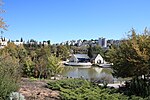The Israel Museum (Hebrew: מוזיאון ישראל, Muze'on Yisrael) is an art and archaeological museum in Jerusalem. It was established in 1965 as Israel's largest and foremost cultural institution, and one of the world’s leading encyclopaedic museums. It is situated on a hill in the Givat Ram neighborhood of Jerusalem, adjacent to the Bible Lands Museum, the Knesset, the Israeli Supreme Court, and the Hebrew University of Jerusalem.
Its holdings include the world's most comprehensive collections of the archaeology of the Holy Land, and Jewish art and life, as well as significant and extensive holdings in the fine arts, the latter encompassing eleven separate departments: Israeli Art, European Art, Modern Art, Contemporary Art, Prints and Drawings, Photography, Design and Architecture, Asian Art, African Art, Oceanic Art, and Arts of the Americas.
Among the unique objects on display are the Venus of Berekhat Ram, the interior of a 1736 Zedek ve Shalom synagogue from Suriname, necklaces worn by Jewish brides in Yemen, a mosaic Islamic prayer niche from 17th-century Persia, and a nail attesting to the practice of crucifixion in Jesus' time. An urn-shaped building on the grounds of the museum, the Shrine of the Book, houses the Dead Sea Scrolls and artifacts discovered at Masada. It is one of the largest museums in the region.









